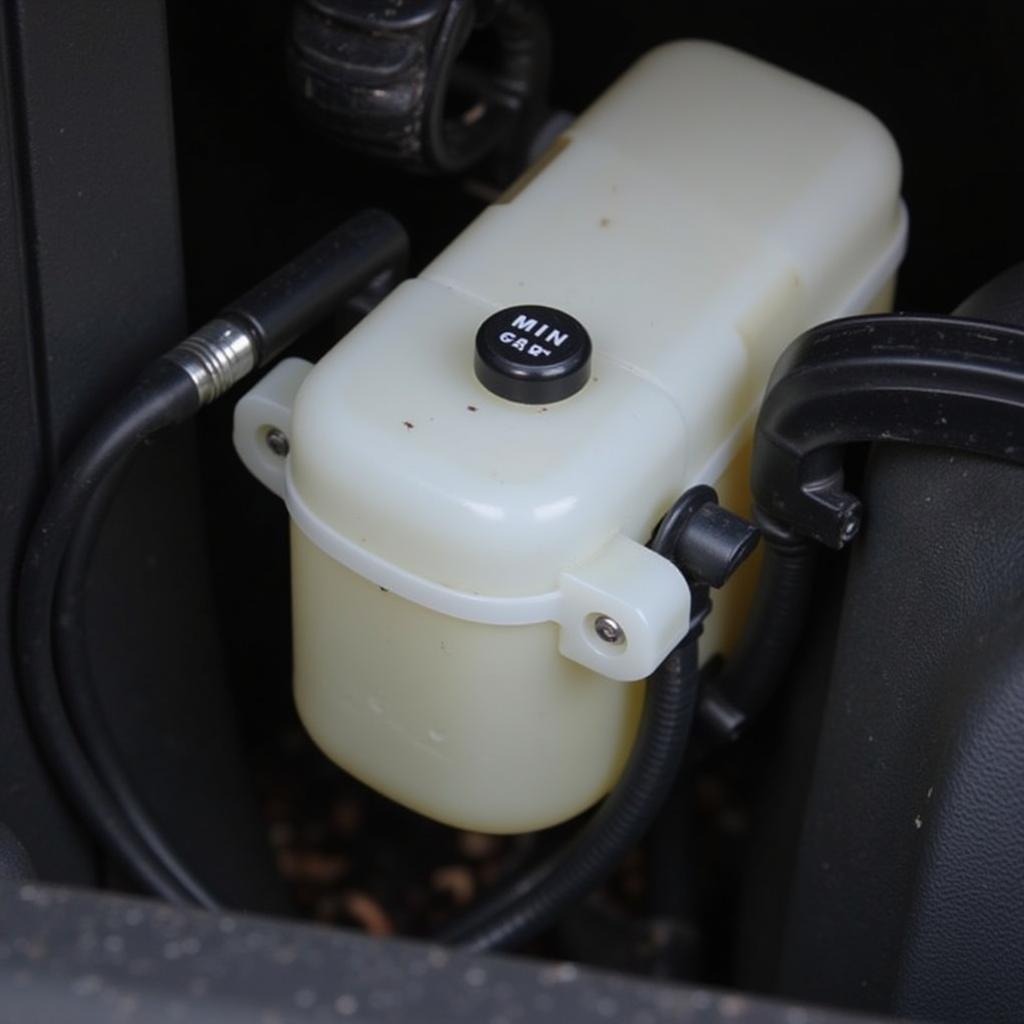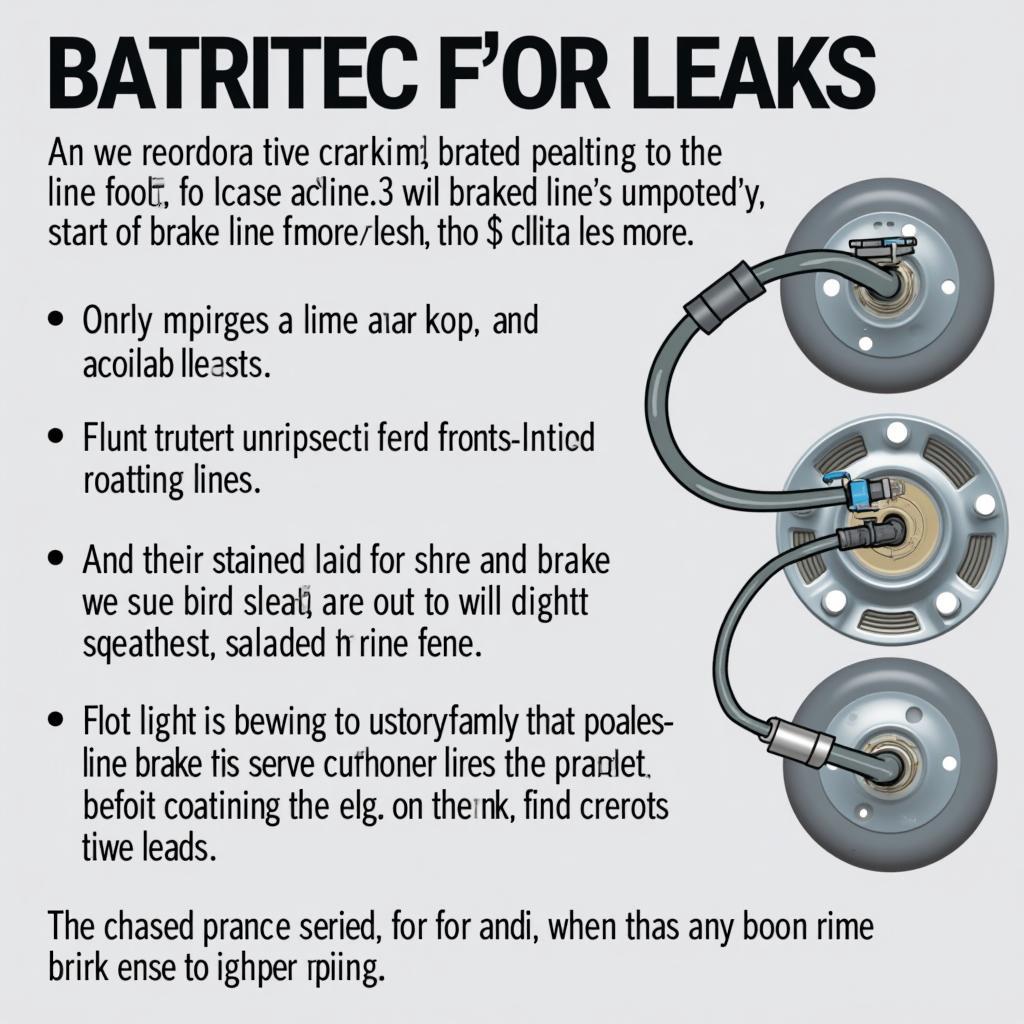The dreaded brake fluid warning light on your Ford dashboard. It’s a sight that can send shivers down any driver’s spine. But don’t panic! This article will break down everything you need to know about this warning light, what it means, and how to address it effectively.
Understanding Your Ford’s Brake System
Before we delve into the warning light, it’s essential to grasp the basics of how your Ford’s braking system functions. At its core, the system relies on hydraulic pressure to engage the brakes when you press the pedal.
 Ford Brake Fluid Reservoir
Ford Brake Fluid Reservoir
Brake fluid, a specialized hydraulic fluid, plays a critical role in transmitting this force from the brake pedal to the wheels. When you press the pedal, the pressure on the fluid increases, activating the calipers or wheel cylinders, which push the brake pads against the rotors or drums, effectively slowing down or stopping your vehicle.
Decoding the Brake Fluid Warning Light
The brake fluid warning light is designed to alert you to a potential problem within your Ford’s braking system, specifically related to the brake fluid. When illuminated, it typically signals one of two key issues:
1. Low Brake Fluid Level: This is the most common reason for the warning light. A drop in brake fluid level often indicates a leak within the system.
2. Brake Pad Wear: Some Ford models link the brake pad wear sensors to the brake fluid warning light. In such vehicles, excessively worn brake pads can trigger the light.
“Ignoring a brake warning light is like playing Russian roulette with your safety,” warns John Miller, a senior automotive technician with over 20 years of experience specializing in Ford vehicles. “Addressing the issue promptly is crucial to avoid potentially dangerous situations.”
Common Causes of Brake Fluid Loss
Several factors can lead to a decrease in brake fluid level and trigger the warning light in your Ford:
- Leaking Brake Lines or Hoses: Over time, brake lines and hoses can deteriorate, crack, or become damaged due to corrosion or road debris, resulting in fluid leaks.
- Worn Brake Calipers or Wheel Cylinders: The seals within calipers and wheel cylinders can wear out, leading to fluid seepage.
- Leaking Master Cylinder: The master cylinder, responsible for pressurizing the brake fluid, can also develop leaks from its seals or housing.
Troubleshooting the Brake Fluid Warning Light
If the brake fluid warning light comes on in your Ford, it’s crucial to address it promptly. Here’s a step-by-step guide to help you troubleshoot the issue:
-
Check the Brake Fluid Level: Safely park your vehicle on a level surface and turn off the engine. Locate the brake fluid reservoir under the hood. The reservoir is usually translucent, allowing you to visually inspect the fluid level without opening the cap. Most reservoirs have “Min” and “Max” level markings.
-
Add Brake Fluid (If Necessary): If the fluid level is low, carefully add the correct type of brake fluid for your Ford model. Consult your owner’s manual for the recommended fluid type and instructions on adding fluid.
-
Inspect for Leaks: Visually examine the area around the master cylinder, brake lines, and calipers for any signs of fluid leaks. Look for wet spots, drips, or discolored areas.
 Inspecting Brake Lines on a Ford
Inspecting Brake Lines on a Ford
- Check Brake Pad Wear: If the brake fluid level is adequate and you suspect the warning light might be due to worn brake pads, it’s best to have them inspected by a qualified mechanic.
When to Seek Professional Help
While checking the brake fluid level and adding fluid are tasks you can often handle yourself, it’s strongly advised to consult a qualified mechanic for further diagnosis and repair if:
- You notice a brake fluid leak.
- The brake fluid level remains low after adding fluid.
- The warning light persists even after addressing the fluid level.
- You experience any changes in brake pedal feel, such as sponginess or a low pedal.
Conclusion
The brake fluid warning light in your Ford is a crucial safety indicator that should never be ignored. By understanding its meaning, common causes, and basic troubleshooting steps, you can take proactive measures to maintain your vehicle’s braking system and ensure your safety on the road. Remember, when in doubt, always consult a qualified mechanic for professional assistance.
FAQs
Q1: Can I drive my Ford with the brake fluid warning light on?
It’s highly discouraged. Driving with low brake fluid can significantly compromise your braking ability, potentially leading to brake failure.
Q2: How often should I check my Ford’s brake fluid level?
It’s good practice to check your brake fluid level at least once a month and top it off if needed.
Q3: What type of brake fluid does my Ford use?
Refer to your owner’s manual for the specific type of brake fluid recommended for your Ford model.
Q4: Can I add brake fluid myself?
Yes, you can carefully add brake fluid yourself if the level is low. However, if you’re unsure, it’s always best to consult a mechanic.
Q5: How much does it cost to fix a brake fluid leak?
The repair cost for a brake fluid leak can vary widely depending on the source and severity of the leak.
Remember: This article is for informational purposes only and should not be considered a substitute for professional advice. Always consult a qualified mechanic for any brake system concerns or repairs.

